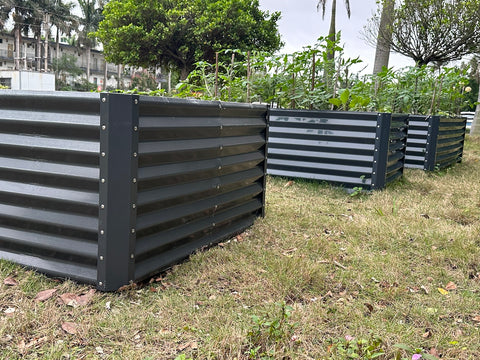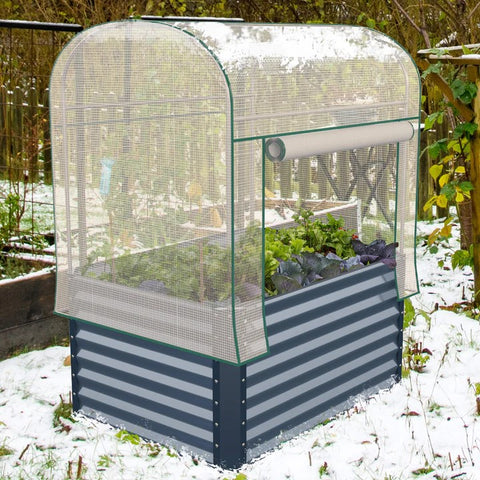Embarking on a journey of gardening is an exciting endeavor, and the decision to start seeds in raised beds is a strategic move for a bountiful harvest. Raised beds offer numerous advantages, from better soil drainage to enhanced control over soil quality. In this blog, we'll explore the art of seed starting in raised beds, providing insights into the benefits, techniques, and tips that will help you get a head start on your gardening journey.The following content also has some reference value for raised garden beds.
Advantages of Seed Starting in Raised Beds

- Optimized Soil Quality:
Raised beds allow for precise control over the soil composition, ensuring optimal conditions for seed germination and plant growth. Gardeners can customize the soil mix to provide the necessary nutrients, aeration, and drainage, fostering a healthy environment for young seedlings.
- Improved Drainage:
Excess water can be a challenge for seeds and young plants. Raised beds, with their elevated design, facilitate better drainage, preventing waterlogging and reducing the risk of seed rot and fungal diseases. This is particularly beneficial during the early stages of seed germination.
- Warmer Soil Temperatures:
The elevated nature of raised beds means that the soil tends to warm up more quickly in the spring. This is advantageous for seed starting, as warmer soil temperatures promote faster germination and encourage robust early growth in seedlings.
- Reduced Soil Compaction:
Traditional garden beds can suffer from soil compaction over time, restricting root growth and water penetration. Raised beds, with their loose and well-aerated soil, minimize the risk of compaction, providing a conducive environment for young roots to establish and thrive.
- Extended Growing Season:
Raised beds offer the possibility of an extended growing season. By starting seeds indoors or in a greenhouse and then transplanting seedlings into raised beds, gardeners can kickstart the growing process, enabling earlier harvests and, in some cases, multiple growing cycles in a single season.
- Pest Control:
Raised beds provide a physical barrier against certain pests, including crawling insects and ground-dwelling critters. This can be particularly advantageous during the vulnerable stages of seedlings when protection is crucial for their healthy development.

Seed Starting Techniques for Raised Beds
- Choose the Right Seeds:
Begin with high-quality seeds from reputable sources. Consider factors such as your climate, the length of your growing season, and the specific needs of the plants you intend to grow. Some seeds benefit from an early start indoors before transplanting to raised beds.
- Prepare the Soil Mix:
Create a well-balanced soil mix for starting seeds in raised beds. Combine high-quality seed-starting mix with compost to ensure a light and nutrient-rich medium. Avoid using garden soil directly, as it may compact and hinder young root growth.
- Use Seed Trays or Containers:
Start seeds in trays or containers before transplanting them into raised beds. This allows for easier management of seedlings and helps protect them from adverse weather conditions during their early stages.
- Provide Adequate Light:
Adequate light is crucial for strong seedling development. If starting seeds indoors, place trays near a south-facing window or use artificial grow lights. Once transplanted into raised beds, choose a location with plenty of sunlight to support continued growth.
- Maintain Optimal Moisture Levels:
Keep the soil consistently moist but not waterlogged. Raised beds can dry out more quickly than traditional garden beds, so monitor soil moisture regularly. Watering from below or using a soaker hose can help keep the foliage dry, reducing the risk of diseases.
- Protect Against Frost:
In regions where late spring frosts are a concern, be prepared to protect seedlings. Use row covers or cloches to shield young plants from frost, allowing for a safer transition from seed-starting trays to raised beds.
- Transplant Seedlings Carefully:
When transplanting seedlings into raised beds, handle them with care to avoid damaging delicate roots and stems. Ensure that the soil in the raised bed is well-prepared and gently water the seedlings after transplanting to help them settle into their new environment.
- Consider Succession Planting:
Plan for succession planting to maximize the use of your raised beds. Start a new round of seeds indoors or in trays while the first batch is growing in the raised beds. This staggered approach ensures a continuous harvest throughout the growing season.
Tips for Successful Seed Starting in Raised Beds

- Monitor Soil Temperature:
Before sowing seeds directly into raised beds, monitor soil temperatures to ensure they are within the optimal range for germination. Using a soil thermometer can help you make informed decisions about when to start planting.
- Protect Against Wildlife:
Raised beds may be less accessible to ground-dwelling pests, but certain wildlife, such as birds and rodents, may still pose a threat to young seedlings. Use protective measures like netting or wire mesh to safeguard your emerging plants.
- Utilize Companion Planting:
Incorporate companion planting principles to enhance the health and productivity of your raised beds. Some plants have natural pest-repelling properties, and strategically placing them alongside your seedlings can contribute to a healthier growing environment.
- Mulch for Moisture Retention:
Apply a layer of organic mulch around seedlings in raised beds to help retain moisture, suppress weeds, and regulate soil temperature. Mulching also contributes to a more stable growing environment for young plants.
- Implement Watering Techniques:
Optimize your watering practices by watering at the base of plants to minimize the risk of fungal diseases. Drip irrigation or soaker hoses are efficient methods for delivering water directly to the soil while keeping foliage dry.
- Thin Seedlings Appropriately:
Once seedlings have sprouted, thin them to ensure proper spacing. Overcrowding can lead to competition for resources and hinder the development of individual plants. Thinning allows for better air circulation and healthier growth.
- Consider Raised Bed Covers:
Raised bed covers, such as hoop tunnels or cold frames, can extend the growing season by protecting against cooler temperatures. These covers create a microclimate that is conducive to seedling development, allowing for earlier plantings and harvests.
- Rotate Crops:
Implement crop rotation in your raised beds to prevent soil-borne diseases and maintain soil fertility. Avoid planting the same crops in the same location year after year to promote a balanced and healthy growing environment.
Conclusion
Seed starting in raised beds offers gardeners a strategic advantage in achieving a thriving and productive garden. The benefits of controlled soil quality, improved drainage, and an extended growing season create an environment where seeds can sprout, grow, and flourish. By incorporating careful planning, proper techniques, and thoughtful tips, you can get a head start on your gardening journey, transforming your raised beds into a verdant oasis of growth and abundance. Whether you're a seasoned gardener or just starting, the art of seed starting in raised beds opens up possibilities for a bountiful harvest and a fulfilling gardening experience.









